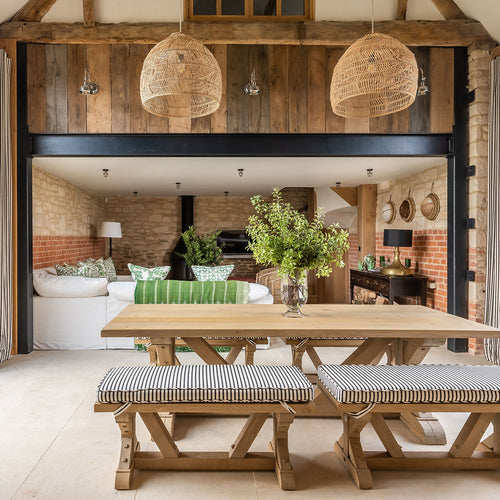THROUGH THE FAWN LENS
Biophilic Design: Bringing the Outside Indoors

Biophilic design is now a well-defined concept in the construction industry and is incorporated into all types of new properties, both commercial and residential. Some people call it rather more simply, bringing the outside indoors, and this works for country properties just as much as it does for urban living.
WHAT IS BIOPHILIC DESIGN?
Nature used to be all around us but currently, 54% of the world’s population live in an urban environment and by 2050, it is estimated that this will increase to 66%. That’s two thirds of the entire global population! Nowadays, people spend 93% of their time indoors separated from the natural world.
City living has plenty of advantages as those escapists to the country discovered when they fled after the onset of Covid-19. Proper drains, better Wi-Fi and unlimited decent coffee are just for starters. However, psychologists know that distancing the human race from nature has the potential to cause real harm both physiological and psychological. This is where biophilic design comes in, a strategic approach intended to harness nature and weave it into the built environment.
BIOPHILIC DESIGN IS FOR EVERYONE
Most humans have an innate love of nature even if they don’t realise it. Nature could be appreciation of a big stormy sky, joy at the changing colours on autumn trees or something as simple as a songbird visiting the garden. If humans are deprived of this connection with nature, then health can suffer as a result.
Biophilic design operates on all levels from grand designs through to community projects right down to small domestic properties. The aim is to trigger a strong and positive uplift in mental health and wellbeing.
It's hard to define biophilic design although plenty have tried. However, there are three core features or tenets and these are:-
- Direct experience of nature
- Indirect experience of nature
- Experience of space and place
How biophilic design applies to individual lives and environments depends on preference and design limitations.

DIRECT EXPERIENCE OF NATURE
This is easy to understand and apply. Direct experience of nature refers to direct contact with plants, water, light or any green element. It includes natural air movement as opposed to no air movement or artificial cooling or heating.
Direct experience of nature is a big feature in designing work environments, educational settings and healthcare buildings.
Plants are beneficial and studies reveal that they enhance creativity, performance and productivity. Incorporating plants into design is one of the easiest and simplest concepts, even for high rise flats.
Water has magical properties which is why riverside or ocean properties are always so sought after. Water has both a visual and an auditory impact. However, water can be incorporated into the interiors of many types of buildings using indoor water features or just the blue of the ocean in bathroom design and ripple tiles which reflect the movement of bath water to create a shimmering effect.
INDIRECT EXPERIENCES OF NATURE
It’s easy to incorporate nature if you have a grand view of the great outdoors or a large interior space, it can become much more challenging in an urban environment where window access is limited, or plants are not desired.
Using natural materials like wood, earth and terracotta and rich textiles which offer variety and texture imbibes a home with a warmth and calmness that is both subtle and powerful. It can also be about maximising natural light by re-designing space and adding windows or doors.
SPACE AND PLACE
Space and place is a culture to improve wellbeing and which can inform design in one or more of several different ways:-
- Providing a place of refuge and security with comfortable and nurturing interiors with cosy and interesting alcoves and lighting changes
- Integrating parts so that different elements or rooms within the environment flow but are also delineated, sometimes also using a central focal point
- Transitional spaces which connect interior spaces with the outside so using porches, decks, atriums, bridges, foyers or just doors
- Mobility, the ability to move comfortably between spaces
- Using local culture and geography to inform design, this might include the use of materials or styling which reflects the landscape or community traditions
Biophilic design is a huge concept, but it is also applicable on a small scale and can work in some shape or form for every style of property. It creates an interior which improves wellbeing, optimises living experience, and sets the building in its cultural and historic landscape. This can be reflected in both traditional and the most contemporary of designs.



